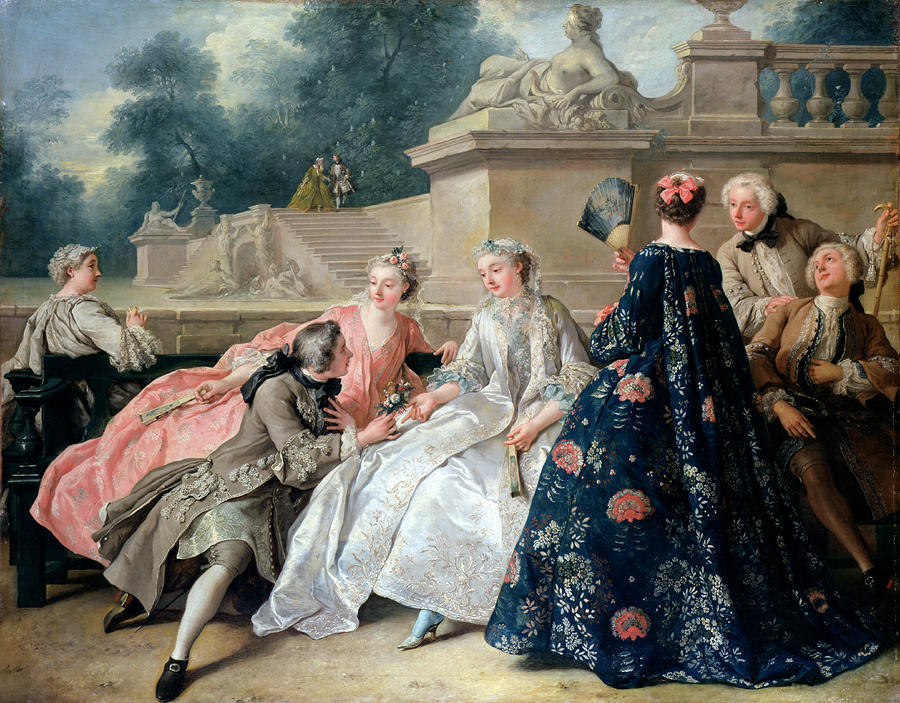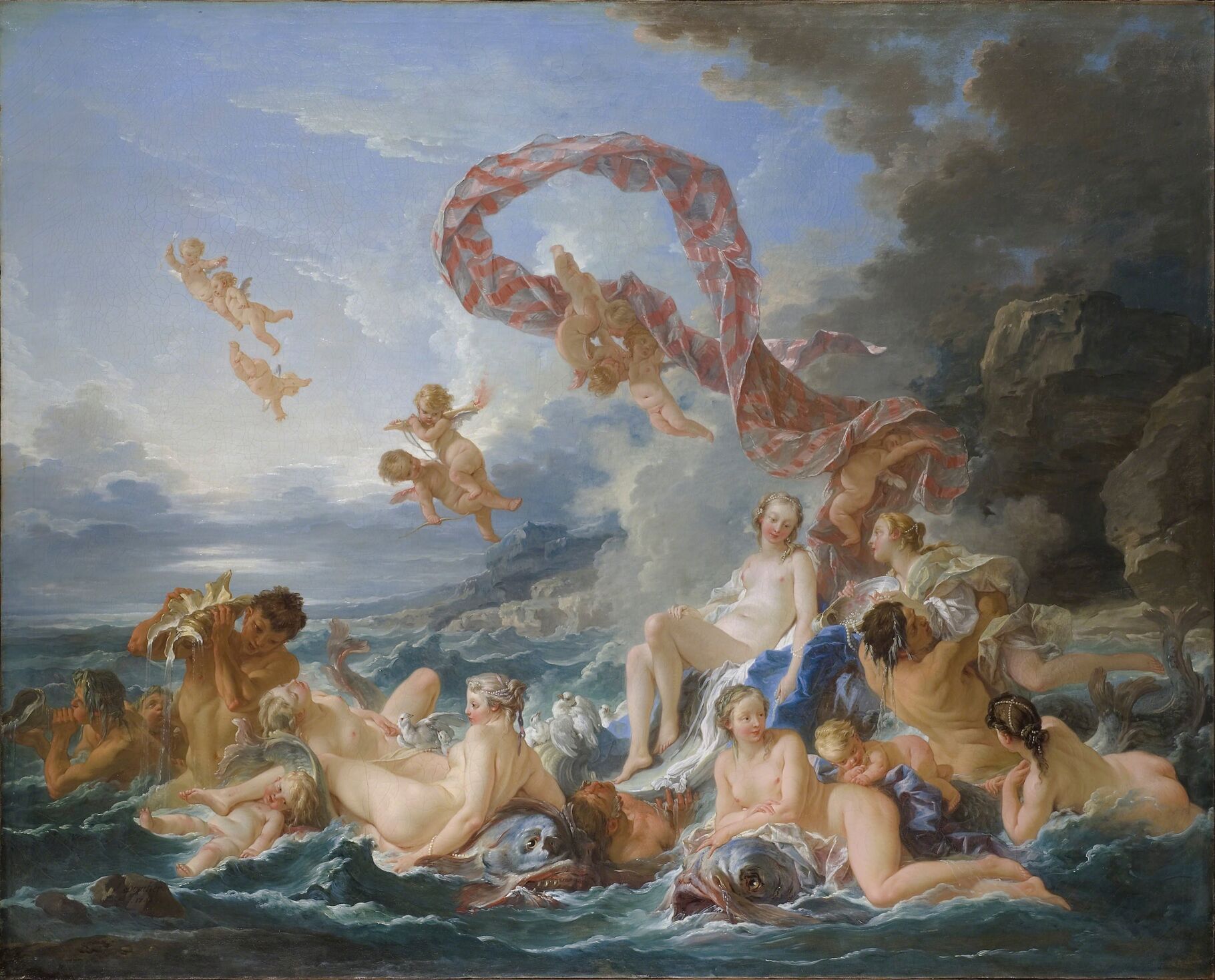Back to the Classics, a Study on 18th Century Art
 |
| The Declaration of Love, Jean-François de Troy (1731) |
18th Century Rococo Artwork
 |
| Birth of Venus, Nicolas Poussin (1635) |
 |
| Triumph of Venus, François Boucher (1740) |
A more easily recognizable piece from the Rococo era would be François Boucher’s Triumph of Venus. In an almost entirely different tone, Boucher’s piece depicts a different side of Rococo painting. Instead of a typical Fête Galante style painting, it takes on more mythological tones while still retaining the usual traits of Rococo pieces, like soft curves and pastel colors. The soft pastels, mythos, and subconscious eroticism of the piece are the defining characteristics that make it a Rococo painting. The pastel pink and white sash in the air above Venus and the cherubs and nymphs are almost obviously inspired by the French baroque painter Nicolas Poussin’s Birth of Venus from 1635. While Boucher’s depiction of the myth was created nearly 100 years after Poussin’s, his interest in Baroque paintings and his renewed focus on mythological stories created an almost clear line to this creation.
The Switch to Neoclassicism
The second half of the 18th century saw an almost immediate switch to a darker, Greco-Roman stylized art world. While some paintings in this era focused on Greek and Roman mythology, others focused on current events. One of these is The Death of General Warren at the Battle of Bunker’s Hill by American painter John Trumbull. This painting is inspired by Greek and Roman paintings, as seen in how the figures are posed. Still, the darker, almost chiaroscuro tones set this drastically apart from the earlier Rococo-style paintings. The soft backgrounds and the intricacies of the subjects’ clothing show that Neoclassicism wasn’t so much of a complete change to Rococo but a subtle shift in ideals. 
The Death of General Warren at the Battle of Bunker's Hill, John Trumbull
_-_Cephalus_and_Aurora_(1789-90)_front%2C_Lady_Lever_Art_Gallery%2C_Port_Sunlight%2C_Cheshire%2C_June_2013_(9103113142).png/702px-John_Flaxman_(1755-1826)_-_Cephalus_and_Aurora_(1789-90)_front%2C_Lady_Lever_Art_Gallery%2C_Port_Sunlight%2C_Cheshire%2C_June_2013_(9103113142).png?20190611174926)
Cephalus and Aurora, John Flaxman (1789)
Neoclassicism was a shift in painting elements and sculpture techniques. Sculptures from this era took on more characteristics commonly seen in antiquity. John Flaxman's Cephalus and Aurora is a prime example. It's not as realistic as works from the Renaissance and Baroque eras; it's soft and idyllic, similar to ancient Greek and Roman statues. For recent comparison, neoclassical statues resembled statues carved during the Renaissance era. They were more serene rather than the intensity seen in Baroque sculptures. They were more calm and linear rather than energetic and horizontal.
Works Cited
“Cephalus and Aurora.” National Museums Liverpool, www.liverpoolmuseums.org.uk/artifact/cephalus-and-aurora. Accessed 7 July 2024.
Seiferle, Rebecca. “Neoclassicism Movement Overview.” Edited by Kimberly Nichols, The Art Story, 9 Nov. 2018, www.theartstory.org/movement/neoclassicism/.
Seiferle, Rebecca. “Rococo Movement Overview.” Edited by Kimberly Nichols, The Art Story, 25 Oct. 2018, www.theartstory.org/movement/rococo/.
“Understanding Rococo Art.” Artsper Magazine, 22 Nov. 2021, https://blog.artsper.com/en/a-closer-look/understanding-rococo-art/. Accessed 7 July 2024.
The focus on Roccoco art and the greater care shown for fine details is evident in your blog. I really enjoy the Neo-classic painting you chose that has strong influences from the art that came mere decades before it. The elements of Greek and Roman mythos exist in all of the pieces you chose, not just in shape or form but also through the storytelling the painting does. I feel that art in this era truly shines because the essence of life is so much more prominent. The goal is not just perfection, but perfection so imperfect that the sky is smeared in smoke while the ground is soaked with blood, the clamor of bodies mix and mingle to form a mass of soldiers. The tension is powerful in Trumbull's piece, yet so beautiful, smooth, and gentle at the same time. I thought putting Trumbull's painting into this collection shows us a great deal more than giving us another obvious Rococo style painting. You see the influences and the attention to detail that resonates with the Classical era within his piece.
ReplyDeleteHello Damien,
ReplyDeleteYour blog post is great at exploring the transition from Rococo to Neoclassical art styles through analyses of these pieces of art. I like how you connect each artwork to broader themes of cultural and artistic evolution. The Rococo focus on leisure in de Troy's piece contrasts with the Neoclassical historical narrative in Trumbull's work. The discussion of historical context adds great depth, providing a deeper perspective on these artistic movements. Your blog post overall does a great job of enhancing our appreciation of how art reflects and shapes societal values over time.
I love your focus on the colors and softness of the art. Rococo was good for its time, but Neoclassical has a whole new vibe to it. I love how simple this blog was while highlighting all the important parts! Highlighting the pastels, contrasts, and softness (such as the dresses I saw you mentioned) helps highlight the important parts of Neoclassical art. You did amazing explaining the transitions and differences in the art. Great blog!
ReplyDelete